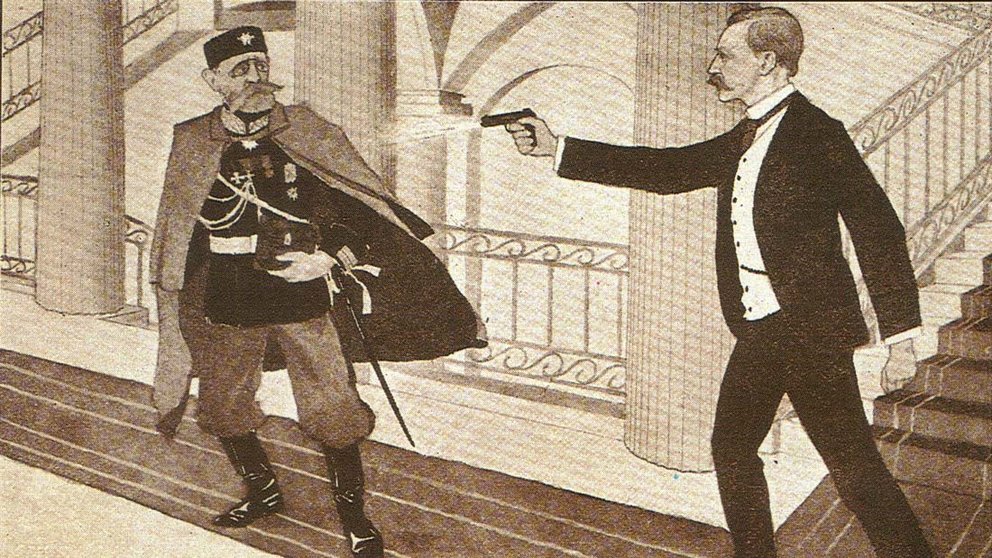He had not only determined his own fate; he had done so a few months in advance.
He knew he would no longer be alive on Thursday. So, when he invited his colleague for lunch on Wednesday but the latter preferred Thursday, he had to say “no.”
“No way, I am already dead by then,” said the 29-year-old accountant.
It was a sunny morning on Thursday, 16 June 1904, in Helsinki. He was looking out of the upstairs window of the Senate building waiting for his target, an old man who had earned utter contempt in the Grand Duchy of Finland for personifying oppression.
Dressed in a military overcoat, the aged man finally arrived at the entrance, stepped inside and started ascending the stairs. His walking stick was creating echoes in the stairway. The killer started walking down the stairs and they encountered each other on the second floor.
A moment passed. No words were exchanged.
Aiming at the target, the young man fired three shots from his Browning gun. The first two bullets did no harm but the third one hit the stomach, leaving the senior lethally injured.
The assassin then executed the final part of his plan. He shot himself in the chest twice and died instantly. When he died, he had no idea if his target was already dead or not.
The elderly man, indeed, did not die. He underwent a major surgery in hospital but finally succumbed to injuries.
The news spread like wildfire. Helsinki residents rejoiced, and Eugen Schauman soon became a national hero for assassinating Finland’s Governor-General Nikolay Bobrikov.
Bobrikov’s rise as tyrant
Bobrikov was assassinated against the backdrop of the first period of oppression in Finland during 1899-1905. It was when Russification policies aimed at restricting or terminating Finland’s autonomous status were introduced.
After becoming the Governor-General of Finland in 1898, Bobrikov quickly became unpopular. The Emperor granting him dictatorial power in 1903 aggravated the situation.
He then accelerated Russification, gradually becoming a hated tyrant in the eyes of Finns.
There was this consensus that killing Bobrikov would end Russification. The Activists -those favouring active resistance to Russification- had already targeted Bobrikov.
Schauman, a Swedish-speaking Finn, was closely observing all this. He was convinced that Bobrikov's death would slow down Russification even if it did not stop the process completely.
He also thought Bobrikov’s murder would convey to the Emperor the sheer discontentment of Finns about oppressive Russification measures.
Before executing his plan, Schauman wrote to the Emperor, apologising and taking full responsibility of his act. He also asked the Tsar to find out himself what was going on in Finland, Poland and the Baltic states.
The letter was found in his pocket.
A distinct plot
Compared to other plots to kill Bobrikov, Schauman’s was unique in several aspects.
First, he had contact with many Activists but had always chosen to act solo. He did not actively interact with them while planning the assassination.
He did not intend to drag others unnecessarily into trouble.
Secondly, as a civil servant, it was easy for him to be in Bobrikov’s proximity. He knew his privilege would allow him to move freely inside the Senate building.
Third, he planned to commit suicide, no matter whether his assassination attempt succeeded or not.
He thought people would consider his wrongdoing in a positive light if he killed himself too.
Indeed, it happened.
Schauman was unanimously seen as a hero who stood up for the whole Finnish population against Russification. Memorials were held and postcards containing his picture with his dog were sold. People paid tributes at his grave.
The Schauman cult was born that strengthened Finns’ opposition to Russification.
A question with no easy answer
Although there was a large-scale acceptance of Bobrikov’s assassination back then, it has often been debated whether Schauman should be regarded as a terrorist or a hero.
Because the incident also involved Schauman’s suicide, people generally viewed it as his sacrifice.
He did not escape after assassinating Bobrikov. Neither did he surrender to the authorities. He killed himself to atone for his misdeed, and people considered the assassination righteous.
Finnish historian Seppo Zetterberg opines the politically-motivated assassination was a terrorist act.
Finnish terrorism expert Dr Christian Jokinen, however, thinks otherwise and mentions two points in Schauman’s favour:
First, the murder –though politically motivated– did not target innocent civilians. Schauman only killed a much-hated tyrant. There was no other casualty.
Second, Schauman did not aim at evoking fear among commoners. He killed a dictator who was increasingly subjecting the Finns to oppression. Bobrikov’s acts were violating Finland’s autonomy granted during its 1809 annexation to Russia.
Thus, it was not a terrorist act in the exact sense of the word.
During the centenary of Bobrikov’s assassination in 2004, Finnish Prime Minister Matti Vanhanen articulately said the murder was an act of terrorism by today’s standards and deplorable altogether.
Nevertheless, public opinion was still significantly in Schauman’s favour after 100 years, which was reflected in the Finnish national broadcaster Yle’s 'Greatest Finns' poll.
Schauman was voted the 34th greatest Finn of all time.
From the stairwell at the assassination scene –which is now the Government Palace– hangs a Schauman memorial plaque that says in Latin: Se Pro Patria Dedit (Given himself on behalf of fatherland).
No matter what Matti’s opinion is about Schauman, the plaque still remains there.









